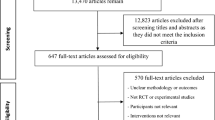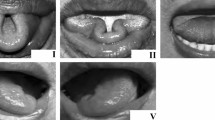Abstract
The Acoustic Voice Quality Index (AVQI) is a relatively new clinical method to quantify dysphonia severity. Since it partially relies on continuous speech, its performance may vary with voice-related phonetic differences and thus across languages. The present investigation therefore assessed the AVQI’s performance in English, Dutch, German, and French. Fifty subjects were recorded reading sentences in the four languages, as well as producing a sustained vowel. These recordings were later edited to calculate the AVQI. The samples were also perceptually rated on overall dysphonia severity by three experienced voice clinicians. The AVQI’s cross-linguistic concurrent validity and diagnostic precision were assessed. The results support earlier data, and confirm good cross-linguistic validity and diagnostic accuracy. Although no statistical differences were observed between languages, the AVQI performed better in English and German and less well in French. These results validate the AVQI as a potentially robust and objective dysphonia severity measure across languages.




Similar content being viewed by others
References
Askenfelt AG, Hammarberg B (1986) Speech waveform perturbation analysis: a perceptual-acoustical comparison of seven measures. J Speech Hear Res 29:50–64
Parsa V, Jamieson DG (2001) Acoustic discrimination of pathological voice: sustained vowels versus continuous speech. J Speech Lang Hear Res 44:327–339
Zraick RI, Wendel K, Smith-Olinde L (2005) The effect of speaking task on perceptual judgment of the severity of dysphonic voice. J Voice 19:574–581
Maryn Y, Corthals P, Van Cauwenberge P, Roy N, De Bodt M (2010) Toward improved ecological validity in the acoustic measurement of overall voice quality: combining continuous speech and sustained vowels. J Voice 24:540–555
Maryn Y, De Bodt M, Roy N (2010) The Acoustic Voice Quality Index: toward improved treatment outcomes assessment in voice disorders. J Commun Disord 43:161–174
Yiu E, Worrall L, Longland J, Mitchell C (2000) Analysing vocal quality of connected speech using Kay’s computerized speech lab: a preliminary finding. Clin Linguist Phon 14:295–305
Ladefoged P (1983) The linguistic use of different phonation types. In: Bless D, Abbs J (eds) Vocal fold physiology: contemporary research and clinical issues. College-Hill Press, San Diego, pp 351–360
Schulman R (1989) Articulatory dynamics of loud and normal speech. J Acoust Soc Am 85:295–312
Higgins MB, Netsell R, Schulte L (1998) Vowel-related differences in laryngeal articulatory and phonatory function. J Speech Lang Hear Res 41:712–724
Dromey C, Ramig LO (1998) Intentional changes in sound pressure level and rate: their impact on measures of respiration, phonation, and articulation. J Speech Lang Hear Res 41:1003–1018
Cookman S, Verdolini K (1999) Interrelation of mandibular laryngeal functions. J Voice 13:11–24
McClean MD, Tasko SM (2002) Association of orofacial with laryngeal and respiratory motor output during speech. Exp Brain Res 146:481–489
Reynolds V, Buckland A, Bailey J, Lipscombe J, Nathan E, Vijayasekaran S, Kelly R, Maryn Y, French N (2012) Objective assessment of pediatric voice disorders with the Acoustic Voice Quality Index. J Voice 26:672.e1–672.e7
Barsties B, Maryn Y (2012) Der Acoustic Voice Quality Index in Deutsch: ein Messverfahren zur allgemeinen Stimmqualität [The Acoustic Voice Quality Index: toward expanded measurement of dysphonia severity in German subjects]. HNO 60:715–720
Hirano M (1981) Psycho-acoustic evaluation of voice. In: Arnold GE, Winckel F, Wyke BD (eds) Disorders of human communication 5, clinical examination of voice. Springer, Vienna, pp 81–84
Chan KM, Yiu EM (2002) The effect of anchors and training on the reliability of perceptual voice evaluation. J Speech Lang Hear Res 45:111–126
Portney LG, Watkins MP (2000) Foundations of clinical research, applications to practice, 2nd edn. Prentice-Hall, Upper Saddle River
Sheskin DJ (1997) Handbook of parametric and nonparametric statistical procedures. CRC Press LLC, Boca Raton
Dollaghan CA (2007) The handbook for evidence-based practice in communication disorders. MD Brookes, Baltimore
Awan SN, Roy N, Dromey C (2009) Estimating dysphonia severity in continuous speech: application of a multi-parameter spectral/cepstral model. Clin Linguist Phon 23:825–841
Lowell SY, Colton RH, Kelley RT, Hahn YC (2011) Spectral- and cepstral-based measures during continuous speech: capacity to distinguish dysphonia and consistency within a speaker. J Voice 25:e223–e232
Kreiman J, Gerratt BR, Khan SD (2010) Effects of native language on perception of voice quality. J Phon 38:588–593
Hartelius L, Theodoros D, Cahill L, Lillvik M (2003) Comparability of perceptual analysis of speech characteristics in Australian and Swedish speakers with multiple sclerosis. Folia Phoniatr Logop 55:177–188
Ghio A, Weisz F, Baracca G, Cantarella G, Robert D, Woisard V, Fussi F, Giovanni A (2011) Is the perception of voice quality language-dependant? A comparison of French and Italian listeners and dysphonic speakers. In: Proceedings of interspeech 2011, pp 525–528
Acknowledgments
The authors thank Dr. Gwen Van Nuffelen (Department of Communication Disorders, University Hospital of Antwerp, Belgium) for her contributions in the perceptual rating of the many concatenated voice samples.
Declarations
The study followed the principles of the Declaration of Helsinki. The authors report no declarations of interest.
Author information
Authors and Affiliations
Corresponding author
Appendix: Number of syllables and phonetic transcriptions of the six sentences that were analyzed in this study
Appendix: Number of syllables and phonetic transcriptions of the six sentences that were analyzed in this study
Dutch sample number 1—Du1—17 syllables
“Papa en Marloes staan op het station. Ze wachten op de trein.”

Dutch sample number 2—Du2—22 syllables
“De noorderwind en de zon waren erover aan het redetwisten wie de sterkste was van hun beiden.”

English sample number 3—En3—18 syllables
“The north wind and the sun were arguing 1 day which of them was stronger.”

English sample number 4—En4—19 syllables
“When light strikes raindrops in the air, they act like a prism and form a rainbow.”

German sample number 5—Ge5—22 syllables
“Einst stritten sich Nordwind und Sonne, wer von Ihnen beiden woll der stärkere wäre.”

French sample number 6—Fr6—21 syllables
“La bise et le soleil se disputaient, chacun assurant qu’il était le plus fort.”

Rights and permissions
About this article
Cite this article
Maryn, Y., De Bodt, M., Barsties, B. et al. The value of the Acoustic Voice Quality Index as a measure of dysphonia severity in subjects speaking different languages. Eur Arch Otorhinolaryngol 271, 1609–1619 (2014). https://doi.org/10.1007/s00405-013-2730-7
Received:
Accepted:
Published:
Issue Date:
DOI: https://doi.org/10.1007/s00405-013-2730-7




